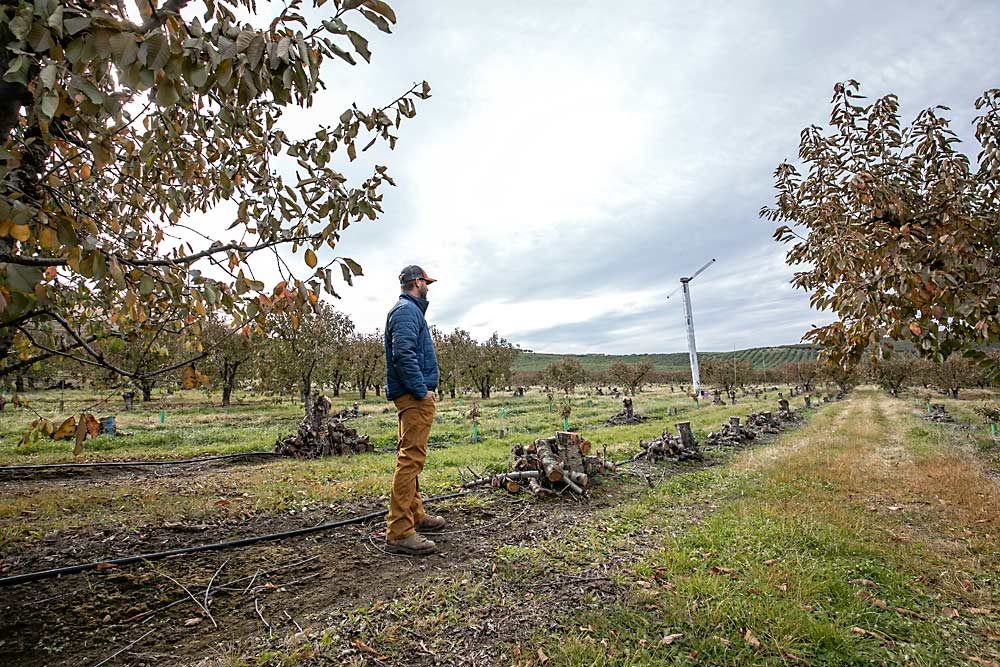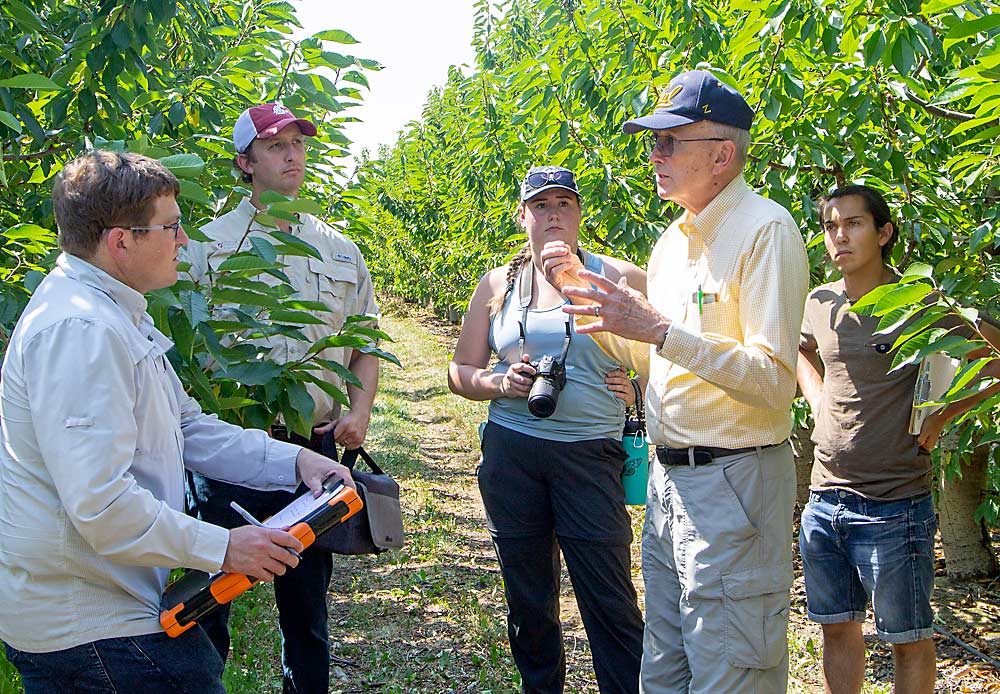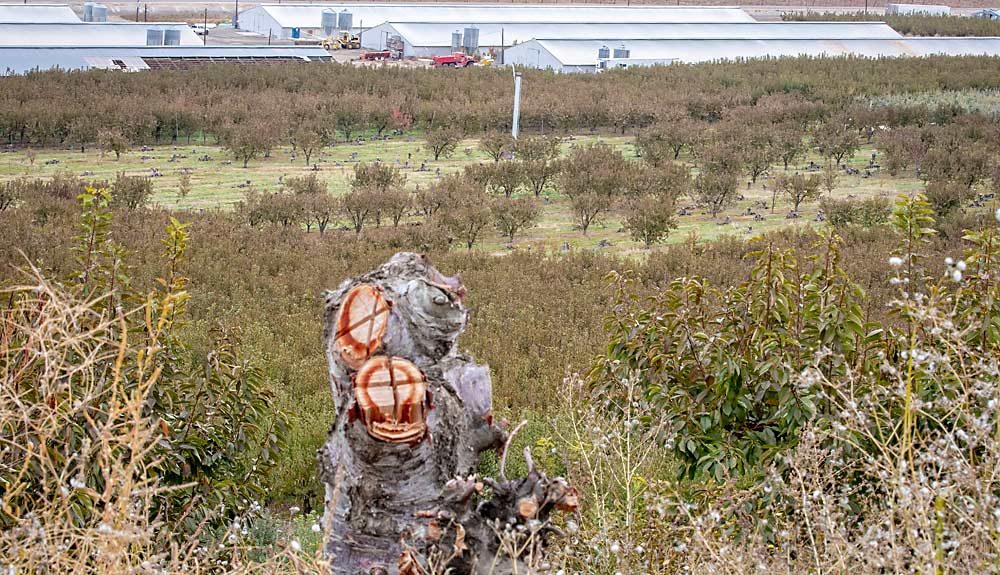
Editor’s note: An update in nomenclature
The small, discolored, unmarketable cherries that are symptoms of what Pacific Northwest growers call little cherry disease actually come from two distinct diseases, caused by different pathogens, that result in similar symptoms and the same management response: removal of the infected trees. Little cherry virus 1 and 2 are aptly named, but confusion arises around the other pathogen, a phytoplasma commonly called Western X in Washington. Researchers say it’s more accurate to call it X disease, caused by the X disease phytoplasma, since modern scientific tools show that the Eastern and Western forms of the formerly mysterious disease agent are the same.
In 2017, this was a really productive Skeena block.
But at the end of 2019, Harris Farms planned to push down the whole thing due to X disease — one of the causes of what Washington growers call little cherry disease.
“It’s devastating. It just breaks your heart to see it move so fast,” said Craig Harris of his family’s cherry orchard east of Yakima, Washington. “But what can we do but be really aggressive?”
They planned to remove about 20 acres this year, after pushing 10 acres last year. Around them, neighboring growers are following suit.
Across the Pacific Northwest, the cherry industry is grappling with epidemic levels of X disease, caused by a phytoplasma pathogen that’s commonly called Western X in the Northwest. It’s spreading faster and farther than anyone expected: The Clean Plant Center Northwest reports the percentage of positive samples has more than doubled and it’s increasingly reported in North Central Washington, too.
Growers responded by increasing their scouting for the signs of infection that can only be seen near harvest, removing symptomatic trees and spraying religiously for the insect vectors, well into what used to be the off-season.
Harris urged growers across the Northwest to make it a priority to search for signs of little cherry disease during the hectic harvest time, because what starts as a few scattered symptoms can spread quickly. Other industry leaders agreed.
“It’s at epidemic levels at this point in time, and we’ve got a very short term to try to get our arms around it before it replants our industry,” said Denny Hayden, a Pasco, Washington-area grower.
Washington State University pathologist Scott Harper began warning of exponential growth in little cherry disease pressure last winter. This year’s sample data showed even higher incidence than he was expecting: About 60 percent of the samples came back positive for X disease. That’s up from 24 percent last year.
“The good news, if there is any good news in this, is the survey is much bigger. We’ve got three times as many samples as last year,” Harper said. That shows that the industry’s message is working, and people are on the lookout for little cherry symptoms.
As for little cherry virus 2, the other primary pathogen that causes little cherry disease symptoms, it accounted for just 1 percent of the samples sent in this year, down from 14 percent last year. Most of those cases were from North Central Washington.
“Active removal efforts up north have gotten rid of a lot of inoculum,” Harper said, pushing the risk down. That’s what the industry wants to see for X disease as soon as possible, but it’s a little more complicated.
“Little cherry virus is stuck in cherry,” Harper said, with no other hosts. On the other hand, the X disease phytoplasma can be found in cherries, other stone fruit, ornamental trees and even weeds, meaning there are a lot more reservoirs to manage. In fact, peach orchards in Washington are seeing rates of infection similar to cherries, he said. Plus, the vectors, leafhoppers, well, hop around. “It’s a landscape problem, not a crop problem,” he said.
Learning from the past
Under guidance from the Little Cherry Task Force formed earlier this year, researchers continue to tackle key questions to help the industry better respond to the outbreak, such as identifying the key risk periods for X disease transmission, for the vectors and the trees, or how leafhoppers move through the landscape during the season.
But such research takes time, and growers don’t have time to spare, WSU entomologist Tobin Northfield said. That’s why he’s made it a priority to learn as much as possible from previous outbreaks of X disease — in California in the 1980s and the Northwest in the 1950s — and lean on research from those outbreaks to “speed us up and identify the paths forward,” he said. “We have to deal with this in the long term, but we also have to focus on getting answers as fast as we can. It may not be perfect, but that’s the best we have.”
So, he invited Sandy Purcell, the now retired University of California, Berkeley entomologist who led the X disease and leafhopper vector research in the 1980s, to visit Washington this summer to share his expertise.
“In the 20 years since I’ve worked on this disease, the tools of science have come a long way,” Purcell said. “But the tools we have for managing it are crude: insecticides and removing trees.”

It took almost 20 years for the California abatement program based on those two tools to work, and in the meantime, X disease, or buckskin disease, as it was commonly called, cut California’s acreage by half, said Jeff Colombini of Lodi Farming. He still sprays for leafhoppers monthly until the end of October but hasn’t seen symptoms for 15 years.
“It was pretty devastating back then,” he said. “I just can’t stress enough the importance of spraying and removing infected trees.”
His father’s cherry block was one of the first known to be infected in 1975. Because it was planted on Mahaleb rootstocks, which resist the phytoplasma by basically walling the roots off from the infected scion, infected trees quickly collapsed. “In some respects, that’s a good thing because you get rid of your Typhoid Marys much more quickly,” Colombini said.
He likened X disease to malaria.
“People control malaria by spraying for mosquitos, because people have malaria before they have the symptoms,” he said. “If a grower is simply taking out infected trees once they show symptoms, it can still spread. The most important thing is to get rid of the leafhoppers.”
But Purcell said that while controlling for leafhoppers from harvest until late fall was important, it’s the tree removal that should be top priority. Reflecting back, he initially thought that tree removal would never work, but it did. That’s because it’s difficult to manage an insect population down to zero vectors — increased sprays have diminishing returns — but removing the inoculum makes a big difference to the disease risk calculations, he said.
“We’re not only trying to reduce the number of vectors, we’re trying to reduce the number of infectious insects,” Purcell said. “You do that by reducing the sources of the pathogen.”
Northfield and Garrett Bishop from G.S. Long Co., which is working with cherry growers in the Yakima Valley, agreed. “If you don’t have any disease surrounding your orchard, it doesn’t matter how many leafhoppers you have,” Northfield said.
“You have to get that disease reservoir out,” Bishop said, adding that some growers may be more aggressive with pesticide application and more lax about tree removal. “The No. 1 thing for me is early detection and tree removal to try to suppress this as much as possible.”
Getting ahead
The lack of early detection tools makes controlling X disease even more challenging. Symptoms typically start in just one branch, then one scaffold, and can slip under the radar.
Trees don’t reliably test positive before they show symptoms, even though they’ve likely been infected for a few years. Unlike viruses, which are relatively easy to detect as they rapidly replicate in plant tissues, Harper said, the X disease phytoplasma is much harder to find.
“It’s like a bacterium, it’s alive,” Harper said. It seems to overwinter in the roots and then slowly recolonize the tree, but it can’t be detected consistently until June. “On a tree that’s 8, 10, 12 feet tall, where is it? It’s a bit of a needle in a haystack,” he said.
He’s studying to see if a different method for detection, such as the genes turned on when the tree responds to the pathogen’s presence, might be better able to predict early infection, but the research will take years.
Until then, growers are playing catch-up with the pathogen. “It’s like you are chasing an invisible domino effect,” Bishop said.
Harris said he did find symptoms this year in trees that tested negative last year, often in trees neighboring those that showed symptoms last year. The clustered spread in his orchards suggests that root-to-root grafting played a role.
To test that theory, he now treats the stumps of symptomatic trees with herbicide. If neighboring trees show signs of herbicide damage, they have to go too.

“That’s one way to get ahead of this. That’s what I mean by being aggressive,” Bishop said. Colombini recommended this approach as well. But the risk of root-to-root grafting doesn’t appear consistent. The age of the tree, rootstock and planting densities all can have an influence, and more research needs to be conducted, Bishop said.
Another key tool may be mapping to understand disease spread, and perhaps even to detect symptoms earlier using sensor technology, Purcell said. Infected trees eventually show a “see-through effect” as the leaves show chlorosis, similar to a micronutrient deficiency, due to how the pathogen is blocking vascular pathways, he said.
Grapevine leafroll virus, a similar virus and vector to little cherry virus 2, can now be detected through aerial image analysis, Purcell said. Maybe X disease could too?
Those tools may be increasingly important because Washington growers are finding a wide variety of symptoms from X disease infection, not just the classic small, bitter fruit, Harper said, and it’s not yet clear why.
“We’re trying to get a better guide to growers for identification, so they can better identify trees and get them out as fast as possible,” Harper said. “It’s just a numbers game and we are on the bad side of the growth curve right now.”
Some growers have looked at that math and decided to pull high-pressure blocks and plant something else. That’s the case with a couple of neighbors, Harris said, but his family’s business is built on cherries, so they plan to replant after a year fallow, followed by more herbicide and fumigation.
“The scary thing is we have three young blocks that will come into production next year,” Harris said. “That’s where early detection would be really helpful, instead of just waiting for harvest. That’ll be a real truth teller.” •
—by Kate Prengaman






Leave A Comment